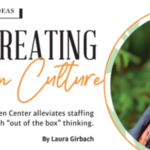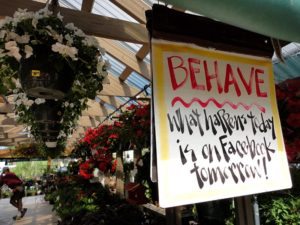
Measuring a customer’s value
Seasonal businesses — like many garden centers — pose some unique “opportunities” that year-round retailers don’t have to handle. Most seasonal stores’ customers shop them once or twice a year, yet almost none of the products have strong recall in customers’ minds, so we’re not top of mind in either specific product or preferred place of purchase.
Recognizing this, we take the approach that we need to reintroduce ourselves to our current and potential customers every year by picking a historically strong, early-season weekend and casting a product/price-focused ad to the broadest possible audience, usually by way of a local newspaper ad supported by social media.
While we hope that the weather cooperates, if it doesn’t, we then hope they remember your name from the ad so, when the sun does shine, they come in to shop your store. This strategy is repeated throughout the season. Notably, your competitors use the exact same strategy and timing.
Based on our historical marketing strategies, our primary focus has been on protecting/building customer count, enticing some new customers to try our brand and getting previous customers to come back to shop — in hopes they all repeat purchase during the season and they buy a lot when they do. As I’ve learned the hard way from my retail and consulting experience, however, hope is not a viable business strategy!
Now, consider the results of our traditional “cast a wide net” marketing strategy; 80% of the customers that respond to this ad strategy only purchase from you once a season, while your most valuable customers (MVCs), who are only 20% of your total customer base, purchase 3.4 times per season and account for 65% to 75% of your total sales (and 80%+ of your total profits). Yet, we continue to spend 90%+ of our marketing budgets to attract the 80% of your customers who come into your store once a year in response to an ad where they cherry pick your assortment to get the cheapest prices, with a high percentage of them never visiting your store ever again.
It’s much more expensive to acquire a new customer than it is to retain an existing customer, the MVC being much more valuable to you in terms of both sales and profits. Based on this, is anyone else questioning the logic of the way we’ve been approaching and investing in our current marketing efforts?
I’m not suggesting that we don’t need or want these new or once-a-season customers; they help expand your reach and base, and, some of them, over time, have the potential to become MVCs sometime in the future.
But think what could happen if you devoted a larger share of your marketing dollars, resources and attention to cultivating a stronger relationship with your current MVCs? Might they increase their frequency of purchase, or increase their transaction purchase value? Maybe they’ll do both simultaneously, so you get the compounded benefit of spending more, more frequently? And an increasing share of their purchases might be made at regular price, not just cherry-picked ad pricing?
With a little TLC, could your relationships with them become stronger, making them vocal advocates, loyalists and ambassadors for your brand? The answer to all these questions is likely yes!
Defining Your MVCs
The (comparatively) high-rolling top 20% of your customers are critical to your stability and ability to grow sales and profits, short and long term. Rather than focusing solely on product, you should seek to better understand exactly who these MVCs are, what their needs and motivators are, and then figure out what you can do to develop a stronger emotional and solutions-based relationship with them.
The emphasis shifts from you simply selling them products to you taking the active initiative to provide value to them, building relationships and creating two-way loyalty and mutual dependence. The objective should be to establish a customer for life, following and maintaining a valued dialogue with that customer.
The philosophy behind this way of thinking is customer lifetime value (CLV), defined as “the measurement of the total expected revenue from a customer over their entire relationship with a company.” It’s a data-driven process that helps you identify who your MVCs really are, their frequency of purchase and an analysis of what they purchased; remember, what gets measured can be managed and improved.
Once you understand exactly who these MVCs are and what motivates them, you can develop methods and strategies to start establishing a long-term value relationship with them.
Yes, the register ring on a single transaction today is important to your immediate success, but establishing and maintaining a relationship with your MVCs for the long term is what ensures that you can operate profitably tomorrow, next year and further down the road.
Incorporating a CLV philosophy into your strategic business thinking changes your whole perspective of what you do and how you do it, all focused on driving the value proposition with your most important customers.
Successful marketing-driven companies are focused on the lifetime value of a loyal customer, not just the sales made to them today. This customer is the one that keeps you viable and in business for the long term. This is the customer who should be most important to you — the one where you place the bulk of your emphasis and the one you strive hardest to satisfy.
Considering Lifetime Value
Here are some examples comparing a transactional and a customer lifetime value perspective.
- Supermarket chains like Kroger or Albertsons look beyond their customer spending $120 per week to their potential lifetime value over 50 years of $312,000!
- Starbucks doesn’t only look at their customer spending $6.90 for a latte 4.2 times per week, but rather that same customer spending over $1,500 per year, and $37,674 over a 25-year span!
- Coca-Cola looks beyond the $10 their customer spends on a 12 pack of Coke products each week to the $20,000+ in purchases over a 40-year life cycle.
If these companies tried to justify the marketing and advertising investments they make based on just the weekly or monthly customer purchases, their return on investment (ROI) would fail miserably. But as an investment to establish and nourish a brand relationship that transcends decades, it makes perfect financial sense.
Further, even at $6.90 for a cup of coffee and looking at things transactionally, it’s tough to justify Starbucks allowing a customer to literally set up shop in their store (squatters) and provide them charging stations and free Wi-Fi. But viewing things from a longer-term perspective of a month, a year or a lifetime, it’s a very viable investment on an ROI review.
Since you’re measuring the transaction value and frequency of visit with CLV, you can more easily measure the effectiveness of new strategies, products and programs to help drive increased transaction value or frequency of visit. But building on the relationship to maximize the potential of CLV is all contingent on being able to consistently maintain higher quality standards, service standards and the overall experience delivered.
We’ve been taught over the years that every customer is important and we sell products one at a time, one visit at a time, one season at a time. We don’t always recognize that some customers are more important than others. You have limited resources — time, money and effort — so it’s crucial that these resources be better used on those customers that can generate the highest return on customer for your business.
The retail experience is supposed to be us identifying customers’ needs and then providing the environment and products that meet those needs. It’s understanding that we need the customer. She doesn’t need us; she has alternatives to what and where she buys. It’s critical for you to identify your core high-purchase/high-profit customers with whom you already have a strong relationship, then add value to that relationship that will make them customers for life.
For an enhanced reading experience, view this article in our digital edition.

















 Videos
Videos





